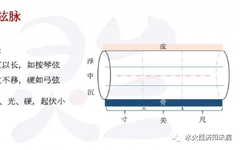The Xian Mai (Xian Pulse) is a common and important pulse pattern in clinical practice, playing a crucial role in assessing the patient’s cold-heat and deficiency-excess conditions.1. What does it feel like to touch the Xian Pulse?The Xian Pulse resembles the shape of a bowstring or a string on a musical instrument. In summary, it is characterized as being “flat, straight, smooth, or hard,” with minimal fluctuations, akin to pressing on a board; this is the essence of the Xian.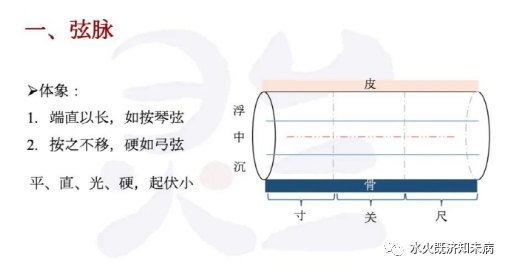 2. What is the patient’s condition when the Xian Pulse is detected?
2. What is the patient’s condition when the Xian Pulse is detected?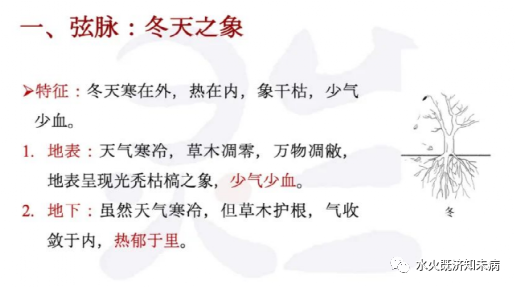 “Xian represents the imagery of winter,” corresponding to the “Hua” (slippery) pulse that symbolizes summer. Specifically, the Xian is a representation of early spring, late autumn, and winter, which we collectively refer to as the imagery of winter. Winter is characterized by cold on the outside and heat on the inside. The imagery is one of dryness, with diminished qi and blood. The surface of the earth is cold, leading to withered plants and a barren landscape, thus the Xian Pulse reflects this lifeless, barren state, with diminished qi and blood. However, underground, despite the cold weather above, the roots of plants are protected, and qi is gathered internally, forming a state of internal heat accumulation, which we call “internal heat stagnation.” In the human body, this corresponds to a surface cold with diminished qi and blood, but often with internal heat stagnation, resembling a cold package of heat; this is the characteristic of the Xian Pulse.3. What symptoms are associated with the Xian Pulse?
“Xian represents the imagery of winter,” corresponding to the “Hua” (slippery) pulse that symbolizes summer. Specifically, the Xian is a representation of early spring, late autumn, and winter, which we collectively refer to as the imagery of winter. Winter is characterized by cold on the outside and heat on the inside. The imagery is one of dryness, with diminished qi and blood. The surface of the earth is cold, leading to withered plants and a barren landscape, thus the Xian Pulse reflects this lifeless, barren state, with diminished qi and blood. However, underground, despite the cold weather above, the roots of plants are protected, and qi is gathered internally, forming a state of internal heat accumulation, which we call “internal heat stagnation.” In the human body, this corresponds to a surface cold with diminished qi and blood, but often with internal heat stagnation, resembling a cold package of heat; this is the characteristic of the Xian Pulse.3. What symptoms are associated with the Xian Pulse?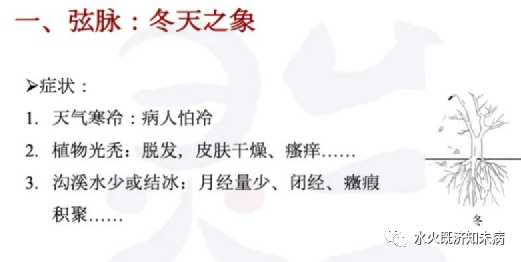 In winter, the cold weather often leads to patients with the Xian Pulse being sensitive to cold. The barren and dry state of winter plants often results in symptoms such as hair loss, dry and itchy skin. Additionally, the water in winter streams is scarce, sometimes even frozen, which manifests in patients, especially women, as generally reduced menstrual flow, amenorrhea, or the presence of masses, including thyroid diseases and breast hyperplasia, which are often reflected in the Xian Pulse.Thus, we say that the Xian Pulse symbolizes winter; in clinical practice, when palpating a flat, straight, smooth, and hard pulse, resembling a flat board with minimal fluctuations, one should envision the cold winter weather, with withered plants, frozen rivers, diminished qi and blood, yet possibly with internal heat stagnation.The imagery of the Xian Pulse is one of cold weather above and internal heat stagnation below, allowing us to infer the main diseases associated with the Xian Pulse. For instance, the Xian is associated with cold, stagnation, pain, water retention, wind, and malaria, all of which relate to the Xian.
In winter, the cold weather often leads to patients with the Xian Pulse being sensitive to cold. The barren and dry state of winter plants often results in symptoms such as hair loss, dry and itchy skin. Additionally, the water in winter streams is scarce, sometimes even frozen, which manifests in patients, especially women, as generally reduced menstrual flow, amenorrhea, or the presence of masses, including thyroid diseases and breast hyperplasia, which are often reflected in the Xian Pulse.Thus, we say that the Xian Pulse symbolizes winter; in clinical practice, when palpating a flat, straight, smooth, and hard pulse, resembling a flat board with minimal fluctuations, one should envision the cold winter weather, with withered plants, frozen rivers, diminished qi and blood, yet possibly with internal heat stagnation.The imagery of the Xian Pulse is one of cold weather above and internal heat stagnation below, allowing us to infer the main diseases associated with the Xian Pulse. For instance, the Xian is associated with cold, stagnation, pain, water retention, wind, and malaria, all of which relate to the Xian.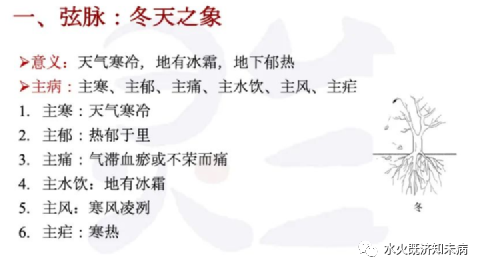 The Xian Pulse symbolizes winter, with cold above and internal heat stagnation below, thus it is often associated with cold and stagnation. Pain associated with the Xian is also common, as qi stagnation and blood stasis or lack of nourishment can lead to pain. Furthermore, the Xian is associated with water retention; one can imagine the frost on the ground in winter, which manifests in the body as a type of water retention. Therefore, the water retention associated with the Xian is often of a cold nature. Additionally, the Xian is associated with wind, representing the cold winds of winter. The Xian is also linked to malaria, as the surface is cold while the interior is hot, making it easy for the Xian to appear in the middle position, leading to a phenomenon of alternating cold and heat, which is a manifestation of malaria.4. How to treat the Xian Pulse?The Xian Pulse symbolizes winter, so we should create a spring-like environment to help the patient transition from the lifeless winter to the vibrant spring.
The Xian Pulse symbolizes winter, with cold above and internal heat stagnation below, thus it is often associated with cold and stagnation. Pain associated with the Xian is also common, as qi stagnation and blood stasis or lack of nourishment can lead to pain. Furthermore, the Xian is associated with water retention; one can imagine the frost on the ground in winter, which manifests in the body as a type of water retention. Therefore, the water retention associated with the Xian is often of a cold nature. Additionally, the Xian is associated with wind, representing the cold winds of winter. The Xian is also linked to malaria, as the surface is cold while the interior is hot, making it easy for the Xian to appear in the middle position, leading to a phenomenon of alternating cold and heat, which is a manifestation of malaria.4. How to treat the Xian Pulse?The Xian Pulse symbolizes winter, so we should create a spring-like environment to help the patient transition from the lifeless winter to the vibrant spring.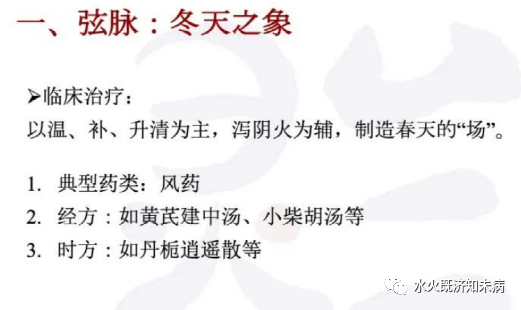 The treatment should primarily focus on warming, tonifying, and uplifting the clear yang. If there is internal heat stagnation in the Xian Pulse, we also need to drain this stagnant fire. Typical herbs that can create a spring-like effect include wind-dispelling herbs. Common formulas include Huang Qi Jian Zhong Tang (Huang Qi’s Center-Building Decoction), Xiao Chai Hu Tang (Minor Bupleurum Decoction), and Dan Zhi Xiao Yao San (Dan Zhi’s Free and Easy Wanderer Powder), all of which are commonly used formulas with excellent effects.5. Additional considerations regarding the Xian PulseThe proportion of the Xian Pulse in the pulse vessel is significant; the larger and more pronounced the Xian, the worse the prognosis generally is. If a young woman presents with a pronounced Xian Pulse, it may indicate difficulty in conceiving, or even if she does conceive, there is a higher risk of miscarriage, as the Xian symbolizes the withered state of winter, which is more characteristic of the elderly. If it appears in a young woman, it indicates a poor constitution, making conception difficult.The explanation of pulse patterns is primarily based on the six guiding pulse types, focusing on the floating, sinking, Xian, Hua, slow, and rapid pulses. The floating and sinking include the cun, guan, and chi positions, primarily assessing the exterior and interior, upper and lower. The Xian and Hua primarily assess cold and heat; the strength or weakness of the pulse and its emptiness primarily assess deficiency and excess. Later, we will discuss the left and right pulse patterns, which mainly assess qi and blood.This is a platform for sharing knowledge of Traditional Chinese Medicine; a place for differentiation and treatment discussion. Friends who love TCM, please follow and share!!!
The treatment should primarily focus on warming, tonifying, and uplifting the clear yang. If there is internal heat stagnation in the Xian Pulse, we also need to drain this stagnant fire. Typical herbs that can create a spring-like effect include wind-dispelling herbs. Common formulas include Huang Qi Jian Zhong Tang (Huang Qi’s Center-Building Decoction), Xiao Chai Hu Tang (Minor Bupleurum Decoction), and Dan Zhi Xiao Yao San (Dan Zhi’s Free and Easy Wanderer Powder), all of which are commonly used formulas with excellent effects.5. Additional considerations regarding the Xian PulseThe proportion of the Xian Pulse in the pulse vessel is significant; the larger and more pronounced the Xian, the worse the prognosis generally is. If a young woman presents with a pronounced Xian Pulse, it may indicate difficulty in conceiving, or even if she does conceive, there is a higher risk of miscarriage, as the Xian symbolizes the withered state of winter, which is more characteristic of the elderly. If it appears in a young woman, it indicates a poor constitution, making conception difficult.The explanation of pulse patterns is primarily based on the six guiding pulse types, focusing on the floating, sinking, Xian, Hua, slow, and rapid pulses. The floating and sinking include the cun, guan, and chi positions, primarily assessing the exterior and interior, upper and lower. The Xian and Hua primarily assess cold and heat; the strength or weakness of the pulse and its emptiness primarily assess deficiency and excess. Later, we will discuss the left and right pulse patterns, which mainly assess qi and blood.This is a platform for sharing knowledge of Traditional Chinese Medicine; a place for differentiation and treatment discussion. Friends who love TCM, please follow and share!!! 
